
CLIMBING CERRO ACONCAGUA - Mendoza, Argentina
SMALL GROUP - WITHOUT GUIDE AND PACK ANIMALS
Elevation: 22,841'
January 2022
Flights from Atlanta to Mendoza: ~$1000 RT, 1 stop, 11 hours
Low
season: Nov 15 to Nov 30 and from Feb 21 to Mar 31 :: $727US for 20-day
climbing permit
Mid Season: Dec 1 to Dec 14 and from Feb 1 to Feb 20 :: $727US for 20-day
climbing permit
High Season: Dec 15 to Jan 31 :: $945US for 20-day climbing permit Permit
Link
Aconcagua is the highest mountain in the Western hemisphere, located in western Argentina, near the Chile border. There are about 3,500 climbers trying the summit each year (info from 2002). The 'Normal Route' is non-technical - a walk-up, following the Northwest Ridge. It is the altitude that poses the most problem. That and the sense that this is an easy climb. Every year people die because they underestimate the task at hand. Respect this mountain and you will fare better. You should not attempt alone, you should always have someone watching you. Much of the hiking is on scree. On the Normal and Polish Traverse routes there are no permanent snow fields, but crampons and ice axe may still be required in some sections. If you are fortunate the final 1,000 feet is covered with ice and snow. You can then crampon up this much more easily than when it is loose scree after a dry winter. In, 2008 the Caneleta had hardpacked snow with some icy sections that were easily cramponed making the top section much quicker (in relative terms). Many who neglected to bring crampons were turned back by these conditions. Passports must be shown. Climbers must surrender details of winter ascents they have made in the past to prove they have the requisite experience to climb Aconcagua. They must sign an affidavit assuming all responsibility for the risks of the expedition. They are obliged to list the equipment they will be using. They must show a valid insurance policy that covers rescue and subsequent medical care. The clock starts ticking when you enter the park, whereupon the permits will be marked at the checkpoint in Horcones for the Normal Route or Pampa de Leñas for the Polish Glacier Traverse Route. You will also be presented with bags for trash and your bodily waste – in common parlance, a sh– bag. These are numbered and surrendered upon exit. Failure to do so incurs a $200 fine.
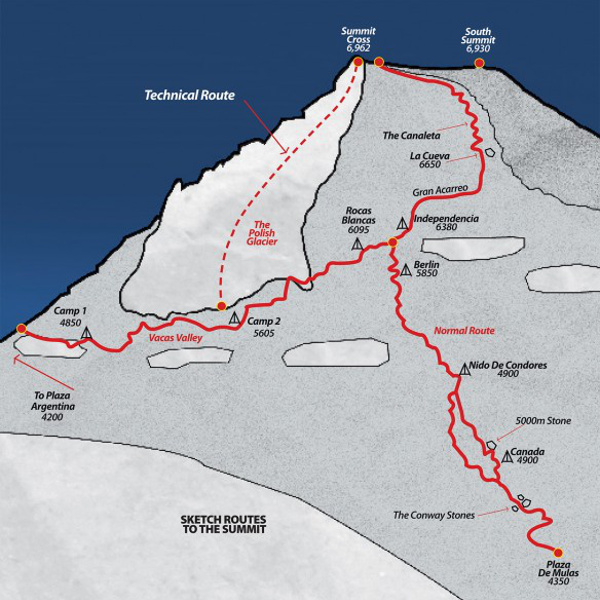
GETTING THERE:
Fly to either Santiago (Chile) then Mendoza (Argentina). Or Buenos Aires
then Mendoza. Take the bus to Puente del Inca or Penetentes. The entrance
to the National Park is either at Puenta del Inca (normal route and
south face). Or the through the Vacas Valley near Penetentes (For the
Polish Glacier, Polish Traverse and Vacas routes).
You must
go to Mendoza Argentina in person to get your climbing permit. To enter
ACONCAGUA PROVINCIAL PARK, you have obtain a permit. You have to fill
out the forms personally. Permits are sold EXCLUSIVELY at
SUBSECRETARÍA DE TURISMO på San Martín 1143. Close
to Plaza Independencia. Most cabs know where this is. When you apply
for your permit in Mendoza you will get a ´banking slip´
from the park office, then go to a nearby "Locatario" to pay
your permit fee. Then you will return to the park office and get your
´climbing permit´.The whole process takes one or two hours
now, more with high season line ups.
An issue if you go through customs at Santiago airport. There is a good chance that you will have all meat and dairy products from your expedition food confiscated upon entering Chile. Stay in transit and take a short (45 min) flight on Lan Chile or Aerolineas Argentinas to Mendoza, Argentina. This will allow you to keep your food, get your permits, possibly see Aconcagua from the air as they fly close to it at times, and save the 100$ U.S. tax Chile imposes on Americans, Canadians and other nationalities.
If you are entering Chile by bus this will not apply.
Possible food issue. Our climbers had their bags searched in Mendoza Argentina for certain food items. While normally climbers are treated seperately in this respects, as the foreign currency is valued we are not hassled. They conficated some food items such as peanuts and items that had been repacked not in the original packaging. Among the items taken were believe it or not..gummy bears. We think the staff was hungry. I packed all my food in 3-day packs in seperate stuff sacks labled, base camp, camp one, and camp two. These were packed at the bottom of my bag under everything and looked like a hassle to get to and open. Thus the customs were reluctant to get that deep in the bottom of my bag. The people that were searched had packed their food in clear plastic making the customs agent job too easy. So pack your food accordingly to avoid any unnecessary hassles.

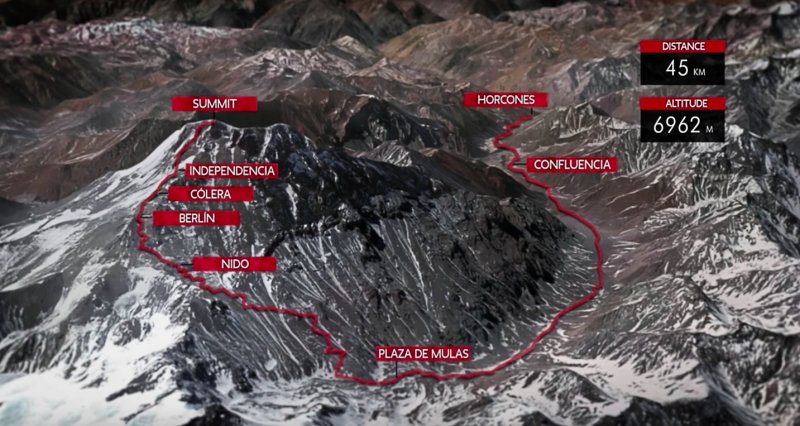
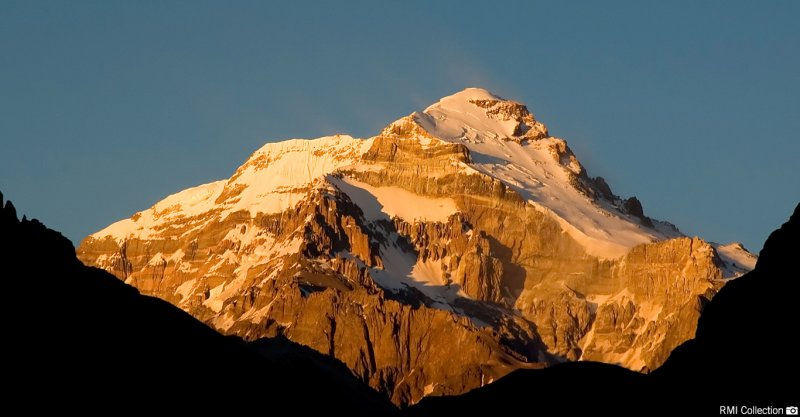
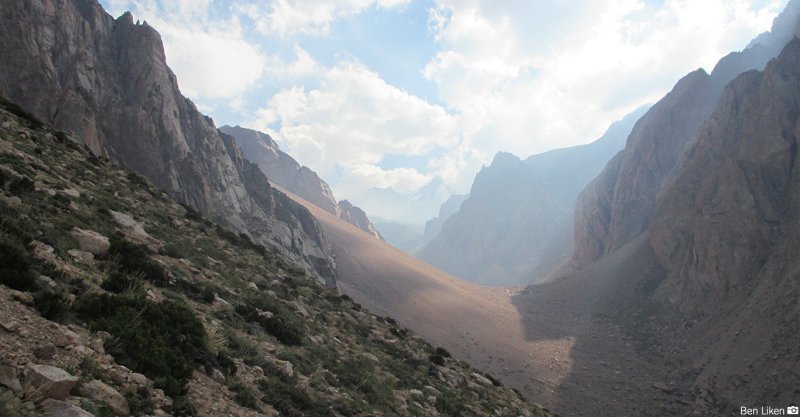












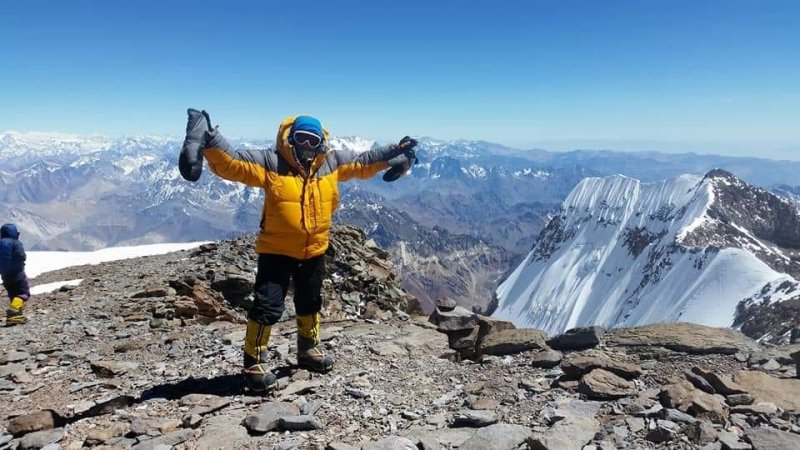
on the Summit of Aconcagua


 State Dept Advisories: Argentina Chile
Travel Insurance Lonely Planet
State Dept Advisories: Argentina Chile
Travel Insurance Lonely Planet
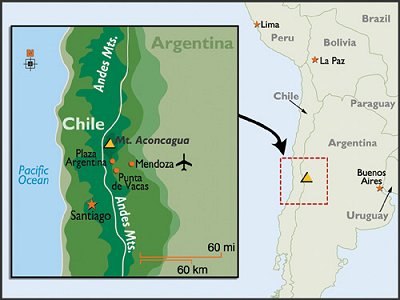
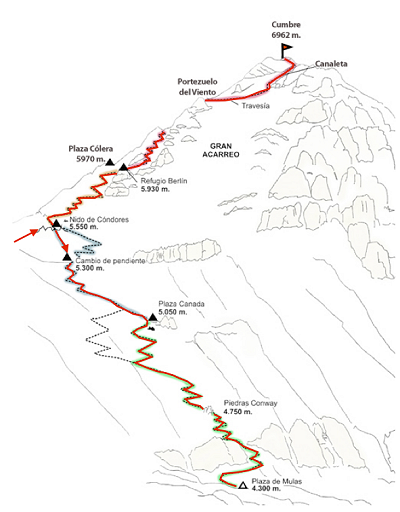 Solo Trek Report with Pix
ACONCAGUA ITINERARY
Solo Trek Report with Pix
ACONCAGUA ITINERARYMENDOZA (760 m / 2493 feet)
Transfer from airport to hotel in Mendoza. Lodging.
2
PENITENTES (2.725 m / 8940 feet)
Purchase Aconcagua Park permits in Mendoza. Drive to Penitentes.
Lodging.
3
CONFLUENCIA (3.390 m / 11122 feet)
Transfer to Horcones (trailhead). Hike to Confluencia. Camp.
4
CONFLUENCIA ¦PLAZA FRANCIA ¦CONFLUENCIA
Trekking to Plaza Francia (4.200 m / 13780 feet), and back to Confluencia.
5
PLAZA DE MULAS BASE CAMP (4.370 m / 14337 feet)
Hiking to Plaza de Mulas. Camp.
6
PLAZA DE MULAS BASE CAMP
Acclimatization day. Instructions on using crampons on Horcones
Glacier.
7
PLAZA DE MULAS ¦CAMP 1 (4.910 m / 16108 feet) ¦PLAZA
DE MULAS
Transport of equipment and supplies to Camp Canada. Return to Plaza
de Mulas Base Camp.
8
PLAZA DE MULAS
BASE CAMP
Acclimatization and rest day.
9
CAMP 1
Climb to Plaza Canada. Camp.
10
CAMP 2 (5380 m / 17650 feet)
Climb to Nido de Condores. Camp.
11
CAMP 2
Carry of equipment and supplies to Camp 3. Return to Nido de Condores.
Camp.
12
CAMP 3 - (5870 m / 19258 feet)
Ascent to Camp Colera. Camp.
13
SUMMIT (6.962 m / 22840 feet)
Camp 3 - Summit - Camp 3.
14
CAMP 3 PLAZA DE MULAS
Return to Plaza de Mulas Base Camp.
15
MENDOZA
Hike out to Penitentes and drive to Mendoza. Lodging.
16
MENDOZA
End of the Aconcagua climbing expedition.
17
CONTINGENCY DAY
Extra day. It can be used in the altitude camps or base camp in
the case of bad weather.
18
CONTINGENCY DAY
Extra day. It can be used in the altitude camps or base camp in
the case of bad weather.
*********************************************************
Gear
List (try to keep weight under 25kg)
Required Personal Equipment and Clothing
Head
Glacier glasses
(100% UV filter and side protection)
Ski goggles
Sun cap or hat (with bandana and visor)
Ski hat (wool or fleece)
Light balaclava (Polypropylene or Capilene)
Upper Body
1 Fleece pullover
(like soft polaretec 100 or 200)
1 Fleece jacket (mid to heavy weight)
1 Parka with hood - for -30°C / -22°F - (down or synthetic),
expedition type (needs to fit over all insulation layers).
1 Rainproof or windproof breathable jacket with hood (we suggest
Gore-Tex)
2 Thermal baselayer shirts (Polypropylene or Capilene)
Cotton T-shirts or shirts
1 Turtleneck or multifunctional headwear of synthetic material (Buff
or similar)
Hands
2 Pairs of
inner thermal gloves (Polypropylene or Capilene)
1 Pair of insulated finger gloves
1 Pair of insulated mittens (fleece, down or polar guard)
1 Pair of over mittens (Gore-Tex, in case your mittens are not made
of waterproof material)
Legs
Light weight
long underwear (tops and bottoms)
Expedition weight long underwear, Polypropylene or Capilene (tops
and bottoms). No cotton blend
Fleece trousers (light weight). Full length side zippers recommended
(bibs are not recommended due to its extra weight).
Wind pants (breathable and waterproof). Full separating side zips
required (we suggest Gore-Tex).
Trekking trousers
Shorts (optional)
Feet
1 Pair of comfortable hiking boots or trekking shoes
4 Pairs of outer socks (thick wool or polypropylene)
3 Pairs of inner socks (thin silk or polypropylene)
2 Pairs of cotton socks (for approach to base camp
1 pair of sandals for river crossings (or Neoprene booties with
sole)
Mountaineering Equipment
1 Pair of plastic
boots (double plastic boots), -40ªC / -40ºF. We recommend
Asolo AFS 8000, Koflach Artic Expedition or Scarpa Vega.
Gaiters (Gore-Tex + Cordura). We recommend Outdoor Research Crocodiles
Crampons with ‘step-in’ bindings (recommended Charlet
Moser Super 12). Not Grivel Rambo, Footfangs or Simond Scorpions.
1 pair of trekking poles (collapsible preferred)
1 ice axe. We recommend Grivel
Backpacks - Duffel Bags
Expedition
backpack: internal frame pack (80 liters / 5000 cubic inches) with
crampons attachment points and ice axe haul loops (we recommend
The North Face and Low Alpine)
Day pack (for approach to base camp)
1 extra large and strong duffel bag with lock (large enough to fit
in all your equipment) to be carried by the mules.
1 smaller duffel bag with lock (to store excess gear in the hotel)
Plastic bags to keep clothing dry
Toiletry bag
Sleeping Gear
Sleeping bag,
expedition quality (for at least -20ºC – -4ºF,).
1 kg. of down preferred (only 650/700 cu. in. fill, very high quality)
Sleeping mat (Thermarest or similar, full length recommended)
Foam pad (only if you bring a Thermarest, to avoid a burst)
Others Recommened
Head lamp (spare
batteries and bulb)
Dish, glass, spoon, knife and folk (unbreakable set to be used at
the upper camps)
1 one-liter stainless steel thermos
2 one-liter water bottle (wide mouth). Water bottle insulated needed.
We recommend Nalgene
1 pocketknife
6 Hand warmers (for summit day)
1 one-liter pee bottle (wide mouth)
1 pee funnel (women). We recommend Freshette
Personal first aid kit (simple)
Sun screen (30-40 solar protection factor)
2 Lips screen (20-40 solar protection factor).
Misc.
Camera (extra
batteries and memory cards)
Book, games, music devices to spend time in tent
Insect repellent coating for hike in clothes
Copies of relevant documents (Passport, maps, directions, etc)
Journal with pens.
Casual clothes for walking around, going to dinner
Small Spanish dictionary with travel phrases
List of critical information